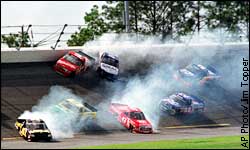
ALSO SEE Dr. Punch: In NASCAR's world, it's always safety first Wallace watches wreck in mirror, wins trucks race Daily Dish: Scary day ends with good news AUDIO/VIDEO   Geoff Bodine takes a scary ride in his truck during the Daytona 250. Geoff Bodine takes a scary ride in his truck during the Daytona 250.avi: 1076 k RealVideo: 56.6 | ISDN | T1  Bodine was conscious as he was taken to the hospital. Bodine was conscious as he was taken to the hospital.avi: 732 k RealVideo: 56.6 | ISDN | T1   Todd Bodine says his brother is doing well. Todd Bodine says his brother is doing well.wav: 189 k RealAudio: 14.4 | 28.8 | 56.6  Glyn Johnston provides an update on the spectators' injuries. Glyn Johnston provides an update on the spectators' injuries.wav: 175 k RealAudio: 14.4 | 28.8 | 56.6 |
